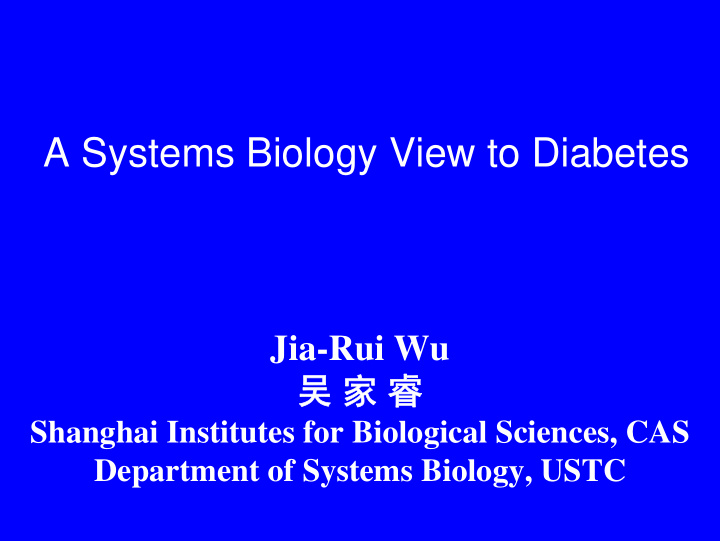



A Systems Biology View to Diabetes Jia-Rui Wu 吴 家 睿 Shanghai Institutes for Biological Sciences, CAS Department of Systems Biology, USTC
New Trends in Life Science in 21 th Century : Systems Biology Part I
Scientific Revolution in Life Science in 21 th Human Genome Project Systems Biology Normal Sciences Central Dogma Scientific Knowledge Scientific Revolution Molecular Biology Normal Sciences Scientific Revolution Time 1950 1990
First Scientific Revolution Change the View of Life
Philosophy for Biologists in 20 th Century: Reductionism Function Central Dogma Protein Gene
One function Research limited in individual gene or protein Classic View of Life: Simple System One protein One gene 2005 , 7 , 1167
Classic View of Life: Simple System Research based on linear interaction
Proteins of Human Genes of Human ~ 300 00 Millions Real Picture of Life
Protein Interaction Network Real Picture of Life Signaling Network
~1.5% for coding protein Genes : ~ 30, 000 23 Chromosome ( 3.3X10 9 bp ) Human Genome Project
Post-Genome Era DNA Books -Omics Rice � Genomics � Transcriptomics � Proteomics Arabidopsis Fish � Metabolomics Thermophile
Novel View of Life in 21 th Century: Holism
Novel View of Life : Complex System signaling ErbB p53 network
Systems Biology View of Life Black Box Input Output Traditional Biology Simple System Input Output A (gene/ B (gene/ Classical Biology protein) protein) Complex System Input Output Systems Biology
Second Scientific Revolution Change the View of Life Science
Process of Biological Knowledge Discovery Wet Lab. Researcher 20 th Century Personal-based Wet Lab. Data Knowledge Wet Lab. Researcher 21 th Century Information-based Wet Lab. Data Dry Lab. Knowledge
Huge amount of Experimental Date
Complexity of Experimental Date Cell signaling Protein interaction network
Computing capability decide understanding biological complexity
Life is information : Digital
Information Flow in Biological System DNA Central RNA Dogma Protein Protein interactive network Cell Tissue Organism
Computing in Biological System
Novel View of Life Science in 21 th Century Traditional Biology Era Life is vitalism Molecular Biology Era Life is machine Post-Genome Era Life is information
Systems Biology Integration Science
Integration of All Kinds of Molecules Proteome Metabolome Transcriptome Citric cycle acid Genome
Integration of Different Levels Organism Cell Gene / Protein Network Gene / Protein
Integration of Small Science and Big Science Experimental Biology ( Hypothesis-driven Science ) Systems Biology Protein interaction Protein structure Gene expression Gene mutation Gene clone Gene “Omics” 1 , 2 , 3 , n ( Protein ) ( Discovery Science )
Integration of Wet Lab. and Dry Lab. Wet Laboratory Dry Laboratory � Molecular Biology � Computing Systems � Cell Biology � Informatics Biology � Genomics � Modeling � Proteomics � Mathematics � Metabolomics
Part II New Way against Diabetes: Systems Biology
Diabetes in the World Nature Reviews Drug Discovery, 2005, 4:367 150 millions diabetes patients / 2000 2006-12-20, UN decided Nov. 14th of every year “World Diabetes Day” to be “United Nations Day”
Answer Question or Solve Question ? 16795 16795 16795 9315 9315 9315 6955 6955 6955 6101 6101 6101 4566 4566 4566 3498 3498 3498 2517 2487 2517 2517 2487 2487 1970 1975 1980 1985 1990 1995 2000 2005 1970 1975 1980 1985 1990 1995 2000 2005
How to study molecular network Challenge One
Tradition Way for Analyzing Diabetes
Knockout-mice used for diabetes research Endocrinology (14) Beta cell (9) Signaling (13) COX-2 NOS Wfs1 TCF2 PTP1B Meg1/Grb10 NPY ACC2 Pdx1 OGG-1 IR Aging galectin-3 apo E p75(NTR) ARNT Stat4 Insulin2 PAI-1 p27(Kip1) HSL cyclin D1 Socs7 SOCS1 USF1 USF2 cyclin D2 IGF-I CD Ifng Orexin P58(IPK) IRS1 IRS2 SHIP2 HO-1 Gas6 2005 Insulin resistance (10) Insulin secretion (8) MC4R AR HNF-4alpha SGK1 GK L-PGDS P35 HNF-4alpha GLUT4 PTEN Fem1b PKClambda Alms1 ORP IA-2 MafA Ikbkb Acc2
Tissue-specific knockout insulin receptor Annu. Rev. Physiol. 2003. 65:313
Diabetes: a disease involving complex network Insulin signaling network IRS Family Nature Rev. Mol. Cell Biol . 2006, 7:85
How to study complexity of systems Challenge Two
Tradition Way for Studying Diseases Gene Linear deduction Gene Gene Gene
Metabolism is system work
Diabetes: dynamic development of systems Cell 1998, 92:593
Animal System is different from Human System Mouse Human Mouse Human MODY gene knockout MODY gene knockout MODY gene mutation MODY gene mutation Hyperglycemia Hyperglycemia Normal Normal PPAR γ -Pro467Leu mut PPAR γ -Pro467Leu mut PPAR γ -Pro467Leu mut PPAR γ -Pro467Leu mut Normal Insulin resistance Normal Insulin resistance “when it comes to the control of intermediary “when it comes to the control of intermediary metabolism and plasma glucose levels, there may metabolism and plasma glucose levels, there may sometimes be important differences between mice sometimes be important differences between mice and humans.” and humans.” Science , 2005 , 307 : 370 Science , 2005 , 307 : 370
Diabetes: Personalized disease Genetic Genetic factors factors Environ. Environ. factors factors Nature 2003, 423,599
Factors involved in Chinese diabetes population 2.6% 2.6% 4X! 4X! 6.07% 6.07% 3.74% 3.74% 1.83% 1.83% 0.67% 0.67% 2002 1980 2002 1980 Rural Small city Big city Rural Small city Big city Genetic factors Environment factors
Systems Biology Solution against diabetes
Biological Atlas of Insulin Resistance - BAIR http://www.bair.org.uk/bair_organisation.html
Strategy of diabetes project in China Type 2 diabetes of Chinese clinic / population Scientific questions Genetic Environment factors factors Study Systems for analysis Methodology Clinic/population Genomics Mol. biology Proteomics Cell biology Metobolomics Genetics Animal model Cell model Bioinformation
What is life? � Components (Nodes) � Interactions (Links) Systems Biologist Life is a statistical complex system rather than a determined simple system
Thank You!
Recommend
More recommend